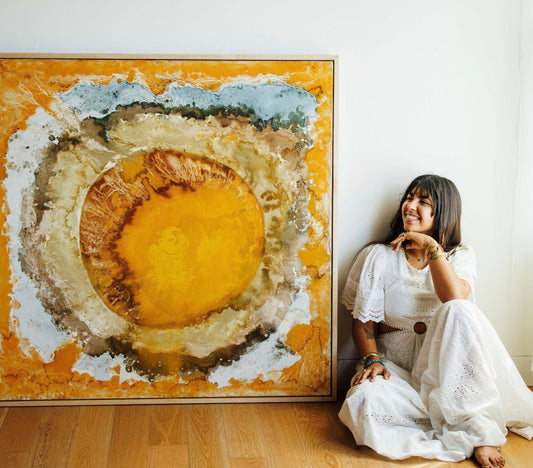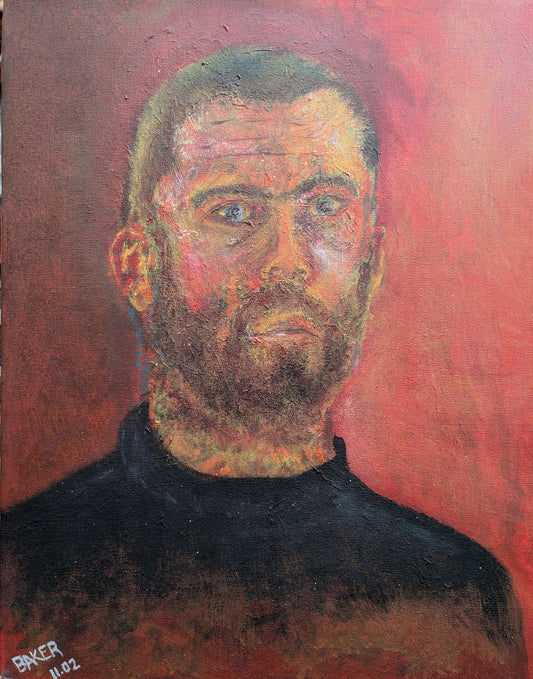Greta Schneider: Embracing the Uncomfortable
Greta Schneider approaches her painting process in an unusual fashion. Before she picks up a paintbrush, she picks up a pen. Her art begins with a story—whether she draws from personal narrative or from works of mythology, Schneider begins by writing about her vision, subsequently crafting her work in its image. Storytelling is important to Schneider. When looking at the breadth of her work, you can see her personal story unfold across canvases, prints, pictures, and sketches, illustrating her perspective of crossing the threshold into adulthood.
At 25, she knows she still has some growing up to do. But she doesn’t seem to fear this change. In fact, she embraces it as joyfully as she embraces the world around her. Schneider’s work consists of bright, surrealist images of her surroundings. She finds both joy and sorrow in her environment and captures its emotional aura through her art. This desire to capture all the nooks and crannies of her world manifests through her expression of several interesting subjects in her work, such as a strawberry planter, a disco ball, or even a tin of fish.

“I'm a deeply, deeply sentimental person, I think a lot of artists are and I have a really, really difficult time separating things from memories,” says Schneider. “So when I'm looking at tinned fish, I'm not just looking at tinned fish. I'm looking at all of the times I've enjoyed tinned fish with my loved ones and my friends.”
As viewers of the work, we feel the sentimentality Schneider wishes to convey. The striking color and amusing design envelop viewers in a contagious warm feeling, creating a sense of vulnerability between us and Schneider.
Vulnerability is a motif seen throughout Schneider’s work. She often depicts herself in nude portrait form or through accompanying poetry attached to her work. It takes courage to portray yourself through your own eyes, but it also creates a sense of solidarity between an artist, their art, and the viewer.
“People have always been very gracious with me and I've had people say ‘thank you for making this piece because I felt the way that you felt, it’s nice to know someone else has gone through that or has had similar feelings.’”

In particular, she touches on the coming-of-age experience, navigating the meaning of self-acceptance throughout the process of growing up. Her earlier portraits showcase the discomfort Schneider had about herself, as most people do in their teens and early twenties. But she did not run from this discomfort—instead, she confronted it by bringing it into a physical form. Even her artistic alias, “Bunny Teeth,” is a welcome embrace of her previous discomfort.
Schneider’s moniker stems from her past insecurity with her front teeth, but after a friend complimented her “bunny teeth,'' she began to appreciate her smile. Schneider then began incorporating bunny imagery into her art as a representation of herself. As she has grown more self-assured, her artistic focus shifted away from herself and toward her surroundings—from a place of self-confinement to one of seeing what’s in front of her.
Though her subjects are often grounded in reality, the technique and color story of each work helps to portray her unique vision. Through brush strokes is one way she alters the reality of her work. The careful movement of the brush creates texture and movement across the canvas, making the work come alive. Her color palettes tend to lean more into a feminine scheme, further showcasing her grappling with the non-linear experience of femininity.
She finds power in the home—the space to exist and be herself—surrounded by art, knickknacks, and two cats named Phoebe and Bruce. The power of the home celebrates the femininity she once tried to reject in her work.
“It's crazy that I spent so long making work that I felt was a rejection of femininity and now I'm focusing on work of my home, and the prescribed role of women in a patriarchal society is homemaking,” says Schneider. “But I think having safe spaces that you can come back to and having a home that you feel safe in is really important.”


The interiors are still an extension of herself, but a much kinder and gentler one than seen in her self-portraits. This lens aligns with what Schneider wishes to evoke in her art. She wants to spark joy, wonder, and occasionally a sense of melancholy. When people view her work, she wants them to recognize the feeling. It is this intuition in her creativity that guides Schneider as she grows as a person and as an artist. When asked what drives her to create she replied, “Because I have to.”
The need to create and capture takes over when words are insufficient, which is ironic seeing how each piece starts as text. Her art fills in the gaps she can not transcribe herself. The whimsy feeling of her work encapsulates a surreal element of day-to-day living that isn’t quite describable. But It is familiar, and that is why she continues to create her art.
Greta may not know what the next evolution of herself will be, but her art will assuredly continue to tell her coming-of-age story. Her art conveys the message she wishes she could have told a younger version of herself—to do the uncomfortable thing and believe in yourself. Her works are an earnest love letter to her life, one that encourages viewers to take on a similar worldly view.
©ArtRKL™️ LLC 2021-2023. All rights reserved. This material may not be published, broadcast, rewritten or redistributed. ArtRKL™️ and its underscore design indicate trademarks of ArtRKL™️ LLC and its subsidiaries.





